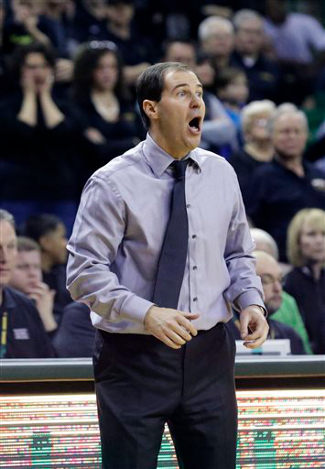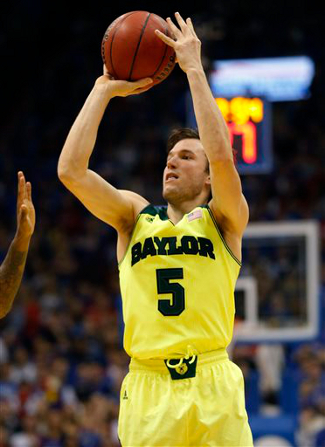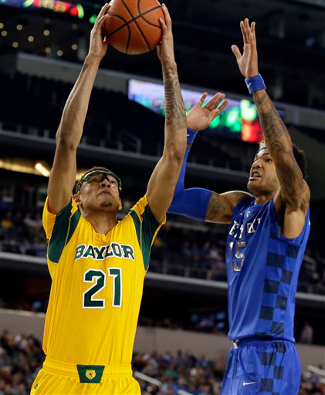Ferrell Center | Waco, TX | Tip: 12:45 P.M. CT TV: Big 12 Network (Affiliate list)/ESPN Full Court/ESPN3 The Texas Longhorns took care of business at home over the last week, knocking off back-to-back ranked teams in Iowa State and Kansas State. The wins propeled Texas from the “First Four Out” of Joe Lunardi’s Bracketology to an 8-seed playing in San Diego on the tournament’s opening weekend. The Longhorn performances also shifted the projections from Ken Pomeroy, making 10-8 the most likely Big 12 finish for Texas. With only one-third of the conference race finished, Texas still has work to do. The Horns need to avoid losses against teams it should beat — namely West Virginia, TCU, and Texas Tech — and pick up a few more quality wins along the way. Today’s road game in Waco provides Texas yet another chance to log one of those quality wins and further increase the odds that the Horns will reach the magical 20-win plateau.
Scott Drew finally watched The Sixth Sense The Longhorns aren’t expected to win the game, with Pomeroy giving them a 34% chance to win and projecting a four-point final margin. However, an upset this afternoon would give Texas some more breathing room in terms of bubble talk, and also give the program its first streak of three consecutive victories against AP Top 25 opponents. The Bears, meanwhile, are in desperate need of a win. After being tabbed as a potential challenger to Kansas’ Big 12 supremacy in the preseason, Baylor has dropped four out of its first five league games. The losses at Iowa State and Kansas didn’t help Baylor’s conference title chase, but they weren’t surprises. The road loss to Tech and a home loss to Oklahoma are what has the Bears reeling, already making them an afterthought in the Big 12 race after just three weeks. The Bears aren’t in danger of missing the NCAA tournament, but they do need to right the ship quickly and start defending their home court. The Longhorns will not only be trying to beat a good Baylor team on the road today, but they’ll be trying to beat a good Baylor team desperate to prove something and get back on track. By the numbers Pace is going to be the biggest clash in this game, with the Longhorns coming in at an adjusted 71.4 possessions per game and the Bears averaging just 63.8 adjusted possessions. Baylor’s slow pace makes them even tougher to beat when you take a look at just how good their offensive efficiency numbers are. The Bears have posted an adjusted OE of 1.147 points per possession, the 29th-best mark in the country. With fewer possessions in the game and an offense that scores so frequently, it only takes a few stops by the Baylor defense to create an edge. That defense isn’t spectacular, as it allows 1.005 points per possession, which ranks just inside the top third of D-I teams. Baylor’s D has stumbled through conference play and is ranked 7th in the league, allowing 1.133 points per possession against Big 12 foes. The Bears have a ton of length that typically makes their zone defense very tough to beat, but they have reacted slowly in recent conference games, allowing opponents far too many open looks. Baylor usually runs a 2-3 or an extended 1-3-1, and most defensive possessions they appear to seamlessly transition between both looks. With 7’1″ Isaiah Austin (No. 21) patrolling the paint and the length of Cory Jefferson (No. 34) and Royce O’Neale (No. 00) on the wings, passes are more difficult for opponents, shots are usually challenged, and Baylor has some leeway to be able to recover from mistakes. On the offensive end, Baylor’s strengths are reclaiming missed shots and knocking down long-range looks. The Bears are ranked third in the entire country with an offensive rebounding rate of 43%, and have posted an even higher mark against conference opponents. In Big 12 games, Baylor has won back 43.9% of its misses, making it very hard for opponents to slow them down. With the Bears already posting an effective field goal mark of 52.4%, it’s absolutely crippling when an opponent actually makes a stop, only to see a neon jersey swipe the ball and put it right back in the bucket.
Brady Heslip is unconscious behind the arc Behind the arc, the exploits of sharpshooter Brady Heslip (No. 5) are well documented. With the Canadian product making more than 47% of his threes, it should come as no surprise that the Bears have an impressive 38.8% team three-point percentage. However, he is not the only accurate long-range shooter, as both Austin and Jefferson can spread the floor and have knocked down 40% of their rare three-point attempts. The wings, O’Neale and Taurean Prince (No. 35), can also hit from long range, with both hovering around the 37% mark. Baylor doesn’t actually take that many threes, but they have enough accurate shooters that opponents have to pay attention to everyone around the arc, not just Heslip, and that can open things up elsewhere on the floor. Meet the Bears The man that makes everything click for Baylor is juco transfer point guard Kenny Chery (No. 1). Coming to Waco from State Fair CC in Missouri, Chery is an incredible leader that simply knows how to get his team on the scoreboard. He’s not incredibly quick, but he takes good angles, uses hesitation dribbles, and has the strength to repeatedly get into the paint for easy looks or to set up teammates by drawing the D. Watching Chery, you will often think that he’s driving into a set defense or that his man has him easily guarded, but a few seconds later he’s at the rim or dumping off to a Baylor big down low. Joining him in the backcourt is senior Gary Franklin (No. 4), an excellent defender and good shooter. Although Franklin has seen his shooting numbers dip in his final season, he’s still a threat to get hot from long range. Texas fans may remember his 3-for-3 performance behind the arc in Austin last year, so they know that he’s always capable of turning in some solid numbers. Baylor runs an eight-man rotation where everyone gets quite a bit of playing time, so although Franklin is a starter, he eats up only 54.6% of his available minutes. Heslip is team’s other backcourt option, and although he comes off the bench, he actually plays just a slight bit more than Franklin. In addition to Heslip’s incredible 47.3% mark behind the arc, he’s also worked on his midrange game the last two seasons. Now, when opponents chase him off the perimeter, he can put the ball on the floor and connect on floaters or pull-up jumpers. The biggest knock on Heslip’s game is his defense, as he often struggles to contain dribble penetration and will get caught falling asleep when he should be providing help. On the wings, O’Neale and Prince both offer the ability to face up and drive to the bucket, and can both knock down the three. Prince has been especially hot from long range in Big 12 play, having made 5-of-11 three-pointers in the last four games. He is also one of the many excellent offensive rebounders on the team, crashing from the wings to reclaim more than 9% of his offensive rebounding opportunities. His size and length have also provided mismatch opportunities in a Big 12 where many teams are opting for smaller lineups or three-guard looks. Baylor has taken advantage of those situations against man defenses, posting Prince up against smaller guards. Jefferson and Austin also provide a ton of offensive rebounds for the Bears, snagging 10% and 9.5% of their chances, respectively. Although neither is exceptionally smooth with the ball, they both have serviceable handles and can face up opponents near the perimeter and get to the rim. Against Oklahoma, Austin even took one defensive rebound and brought it all the way up the floor before being rejected by Ryan Spangler at the rack.
Isaiah Austin has focused on his inside game this season Last season, Austin tended to hang out around the arc and settle for long jumpers or threes. Early this year, he still took his share of long jumpers, but was completely ignoring the three-point shot. It seems that the Baylor coaching staff recently asked him to start taking advantage of those opportunities, as he has suddenly committed to taking — and making — long-range shots in his last two games. After going just 1-for-7 on threes in the team’s first 16 games, Austin has taken 11 threes in his last two games and made six of them (54.5%). The final piece of the core rotation is Rico Gathers (No. 2), an absolute tank of a man who leads the nation in individual offensive rebounding. At just 6’8″, Gathers has reclaimed 22% of the offensive board opportunities when he’s on the floor, repeatedly breaking the will of defenses by getting an easy putback after they had worked so hard to force a missed shot. That rebounding acumen allows Baylor to keep their length on the wings even when Austin goes to the bench, as Gathers typically guards the lane in their zone in those situations. Although that eliminates the shot-blocking threat down low, being able to leave Jefferson and Prince or O’Neale on the wings limits open threes and makes it harder to get the ball into the paint. Keys to the game 1) Clean up the defensive glass – Baylor is not only the best offensive-rebounding team in the Big 12, but also one of the best in the nation. Although Texas has generally been very strong on the boards, the team will have its hands full trying to keep the Bears off the glass. The Longhorns were undone by Oklahoma’s offensive rebounding in their home loss to the Sooners, and a similar performance on the boards will spell disaster in Waco this afternoon. While Texas isn’t going to be able to dominate the defensive glass against this Baylor team, the Horns need to limit the number of second chances, especially when it gets down to crunch time. 2) Stick to Heslip like glue – Brady Heslip needs very little time or space to get off a shot behind the arc, and the Bears do a good job consistently running him off of screens to get him that little bit of separation. The Horns have had their struggles limiting damage from good three-point shooters this season, and they simply cannot afford to let Heslip go crazy today. The Bears are going to run the Longhorn defense ragged with staggered screens off the ball, so Texas has to communicate and offer help when the defenders inevitably get hung up. 3) Don’t let the ball stick – The Longhorns will have to be patient against the Baylor zone, but patience doesn’t equate to waiting. Texas needs to keep the ball moving and use dribble penetration to attack the gaps. The Baylor defense has sprung some leaks in Big 12 play, with Texas Tech exposing their weaknesses in a phenomenal performance up in Lubbock. The Red Raiders moved the ball quickly, passed it well out of the high and low post, and made good cuts off the ball. Baylor’s zone not only has the usual gap right in the middle, but also has a ton of space about twelve feet out on the baseline. If the Longhorns can avoid their bad habits of dribbling the ball too much beyond the arc and passing without purpose, there are points to be had against the Bears. |











